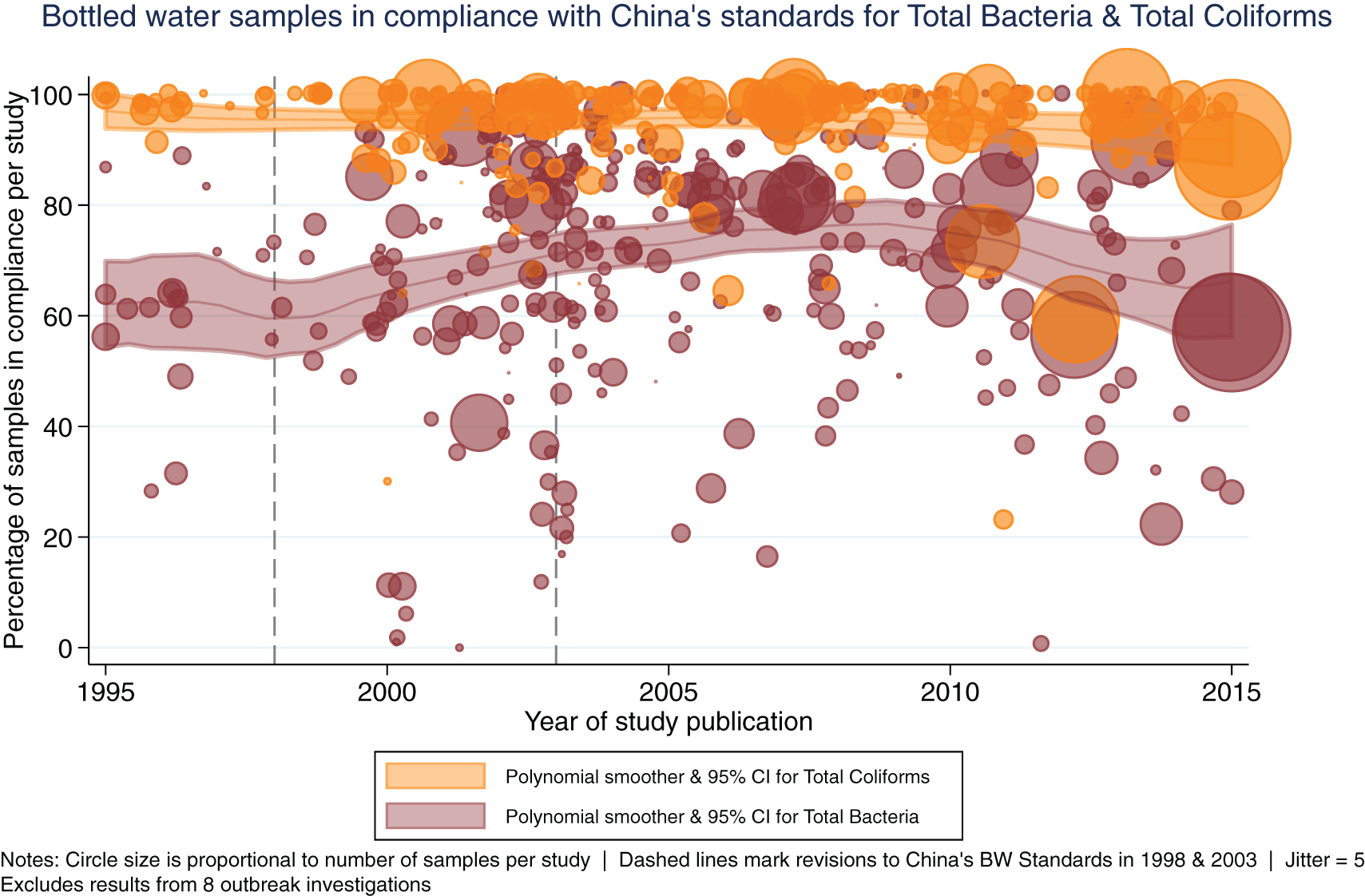Bottled water quality and associated health outcomes: A systematic review and meta-analysis of 20 years of published data from China
Abstract/Summary: Bottled water is a rapidly growing yet relatively understudied source of drinking water globally. In addition to concerns about the safety of bottled water, the adverse environmental health and social impacts associated with bottled water production, distribution, consumption, and reliance are considerable. Our objective was to comprehensively review, analyze, and synthesize ∼20 years of publicly available data on bottled water quality and associated health outcomes in China. We conducted a systematic review and meta-analysis of publicly available studies of bottled water quality and associated health outcomes in China published between 1995 and early 2016 (in Chinese and English). We pre-specified and registered our study protocol, independently replicated key analyses, and followed standardized reporting guidelines. Our search identified 7059 potentially eligible records. Following screening, after full-text review of 476 publications, 216 (reporting results from 625 studies) met our eligibility criteria. Among many findings, 93.7% (SD = 10.1) of 24 585 samples tested for total coliforms (n = 241 studies), and 92.6% (SD = 12.7) of 7261 samples tested for nitrites (n = 85 studies), were in compliance with China’s relevant bottled water standards. Of the studies reporting concentration data for lead (n = 8), arsenic (n = 5), cadmium (n = 3), and mercury (n = 3), median concentrations were within China’s standards for all but one study of cadmium. Only nine publications reported health outcome data, eight of which were outbreak investigations. Overall, we observed evidence of stable or increasing trends in the proportions of samples in compliance over the ∼20 year period; after controlling for other variables via meta-regression, the association was significant for microbiological but not chemical outcomes (p = 0.017 and p = 0.115, respectively). Bottled water is typically marketed as being safe, yet in most countries it is less well-regulated than utility-supplied drinking water. Given the trend of increasing bottled water use in China and globally—and the associated environmental health impacts—we hope this work will help to inform policies and regulations for improving bottled water safety, while further highlighting the need for substantially expanding the provision of safe and affordable utility-supplied drinking water globally.
Bottled water quality and associated health outcomes: A systematic review and meta-analysis of 20 years of published data from China
Authors: Cohen, A., Cui, J., Song, Q., Xia, Q., Huang, J., Yan, X., Guo, Y., Sun, Y., Colford, J. M., & Ray, I.
Publication Year: 2022 | Journal / Publisher: Environmental Research Letters
Abstract/Summary: Bottled water is a rapidly growing yet relatively understudied source of drinking water globally. In addition to concerns about the safety of bottled water, the adverse environmental health and social impacts associated with bottled water production, distribution, consumption, and reliance are considerable. Our objective was to comprehensively review, analyze, and synthesize ∼20 years of publicly available data on bottled water quality and associated health outcomes in China. We conducted a systematic review and meta-analysis of publicly available studies of bottled water quality and associated health outcomes in China published between 1995 and early 2016 (in Chinese and English). We pre-specified and registered our study protocol, independently replicated key analyses, and followed standardized reporting guidelines. Our search identified 7059 potentially eligible records. Following screening, after full-text review of 476 publications, 216 (reporting results from 625 studies) met our eligibility criteria. Among many findings, 93.7% (SD = 10.1) of 24 585 samples tested for total coliforms (n = 241 studies), and 92.6% (SD = 12.7) of 7261 samples tested for nitrites (n = 85 studies), were in compliance with China’s relevant bottled water standards. Of the studies reporting concentration data for lead (n = 8), arsenic (n = 5), cadmium (n = 3), and mercury (n = 3), median concentrations were within China’s standards for all but one study of cadmium. Only nine publications reported health outcome data, eight of which were outbreak investigations. Overall, we observed evidence of stable or increasing trends in the proportions of samples in compliance over the ∼20 year period; after controlling for other variables via meta-regression, the association was significant for microbiological but not chemical outcomes (p = 0.017 and p = 0.115, respectively). Bottled water is typically marketed as being safe, yet in most countries it is less well-regulated than utility-supplied drinking water. Given the trend of increasing bottled water use in China and globally—and the associated environmental health impacts—we hope this work will help to inform policies and regulations for improving bottled water safety, while further highlighting the need for substantially expanding the provision of safe and affordable utility-supplied drinking water globally.
PDF on Publisher Website | PDF on OSF

